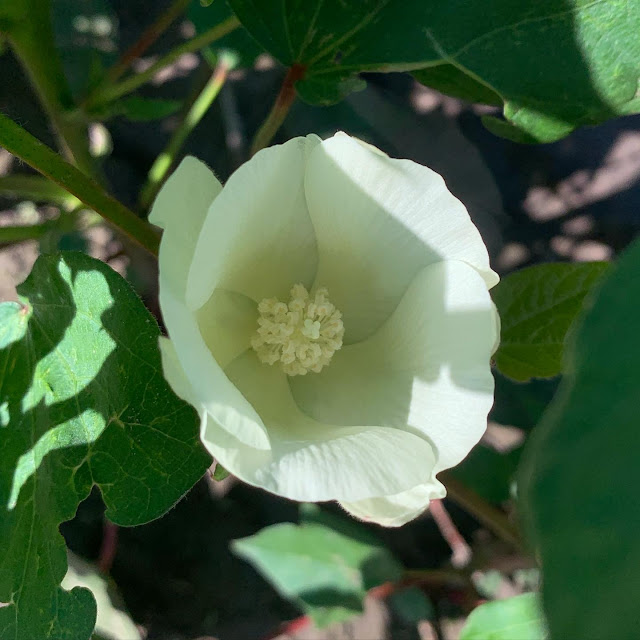 |
Hail Damaged Cotton
Photo: Ben Crumley |
Howdy,
I hope everyone around got the rain they needed this week, and hope you get it soon if not. I know a few places got hail along with our much needed rainfall. If you did get hail, if the growth point wasn't damaged the cotton will very likely bounce back. If you've got stand reduction or severe hail damage, fields can still be considered viable with stand counts as low as 13,000 to 26,000 plants per acre, as long as they are fairly evenly spaced. Damage to the growth point due to hail can result in cotton with multiple main stems rather than one dominant stem. The cotton will wind up without apical dominance, and can have a more bush like appearance with multiple main stems.
Some of our younger cotton and replanted cotton is still susceptible to thrips damage, and will be until they have 5 true leaves.
Thrips are a small (about 1/15") light tan or straw colored insect with a punch and suck type mouthpart and asymmetrical mandibles. They punch a hole with one side, then siphon the juice out with the other. They feed one plant cell at a time, and march along punching and sucking as they go. The adults are winged, can travel short distances on their own, and can be carried by a breeze for a fair distance. Larvae hide on the underside of the leaves, often close to the leaf veins, as well as in the terminal of the plant. Feeding damage for this insect causes the leaves to crinkle and curl, and often looks silvery when examined. Thrips feeding can cause delays in plant maturity and eventual yield reduction.
 |
Western Flower Thrips Adult
Photo: Kate Crumley |
While the insects are visible to the naked eye and scouting can be done just by examining the plant, it is easy to miss some of the smaller larvae. Smacking a cotton plant around on the inside of a cup will knock them off and can make them easier to count. This video Blayne Reed put together has techniques for scouting thrips as well. Cotton with a neonicotinoid seed treatment is usually safe from thrips for about 2-3 weeks after emergence. Seedlings in a sandier soil will lose the effects of a seed treatment more quickly than those in heavier clay soils. Rainfall can also impact how long the seed treatments are effective, the more it rains the shorter the amount of time the seed treatment stays effective.
 |
Thrips Feeding Damage
Photo: Kate Crumley |
The economic threshold for thrips is one thrips per true leaf of the plant until the 5th true leaf stage. Once the plant reaches this stage, treatment for thrips is rarely justified. Check out the cotton insect guide at this website for more information.
 |
Aphids on Cotton
Photo: Kate Crumley |
The threshold for cotton aphids is 50 aphids per leaf, and if you see the aphid mummies in the field, that's a good thing. Parasitoid wasps lay eggs in the aphids, and the aphid forms a mummy while the wasp larvae pupates inside. These wasps, lady beetles, and lacewings all can make a dent in aphid numbers. Treatment for aphids is very rarely justified since the numbers need to be so high before they can cause an economic problem. If you do decide to treat for aphids, do not use a pyrethroid. Pyrethroids are non specific, and kill predatory insects as well, but aphids will bounce back quickly due to their high reproductive rate.
 |
Cotton Fleahopper Adult
Kate Crumley
|
Cotton fleahopper numbers are rising in some places this week, and with squaring under way in many fields, we'll be needing to keep a closer eye out for this pest.
Fleahopper feeding will cause squares to drop. Plants can recover for and compensate for some square loss, but the threshold for fleahoppers is 15-25 per 100 plants. I check for fleahoppers by inspecting the plant terminals once they start squaring. I look at 25 plants per stop in the field, usually checking 100 plants total in an 80-100 acre field, more if the field is larger. Fleahopper nymphs can be close to the size of aphids, but look like smaller versions of the adults without wings, and are much more mobile than aphids.
The chart below contains insecticide suggestions from cottonbugs.tamu.edu (also a good resource) for reference if you have fleahoppers at the action threshold this upcoming week.
If you have any questions feel free to contact me. Wash your hands and stay safe everyone. I look forward to getting to see some of you in person again soon!
Sincerely,
Kate Crumley
For More Information on COVID-19:























